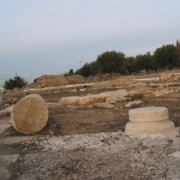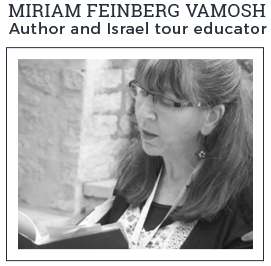Har Adar: My Judean Mountains Home
Har Adar: My Judean Mountains Home
I live in Har Adar, a community of approximately 1,100 families (about 4,000 people) in the Judean Mountains about 8 miles northwest of Jerusalem. It doesn’t appear on most maps, but you can find the nearest two communities, the Arab town of Abu Ghosh (see more below) and Kibbutz Ma’aleh Hahamisha.
My husband Arik and I moved to Har Adar from Jerusalem about 25 years ago with our two little girls when the community was just getting started. In those days it was still called Givat Ha-Radar – that’s Hebrew for Radar Hill, which got its name because there was a radar station here during the British Mandate. The community chose the name Har Adar because it sounded something the previous name, but also had a nice ring to it in that Har means mountain and Adar comes from a root meaning “grand.”
Har Adar was a battle site in two of Israel’s wars, in 1948, when Israel failed to capture the site (which was a military outpost) and in 1967, when we did. Israel tried so hard to capture the site because it is one of the high points along a strategic ridge north of the Jerusalem. When we had the dedication ceremony of the community in around 1985, the late Maj. Gen. Uri Ben-Ari, who fought at Har Adar in both wars, moved the audience very much when he told us he never could have dreamed that children would be playing where once there was only the thick smoke of battle. Har Adar is located very close to the Green Line, the pre-1967 border. Our closest Palestinian neighbors are the villages of Bidu, Beit Suriq, Katana and el-Qubeiba. Har Adar’s old Arabic name is Jebel Kawqab, which means “Mount of the Star.”
My biblical neighborhood
I wish I could take you on a guided tour around my neighborhood, so I could show you how we can see a biblical landscape or archaeological site from almost any vantage point. Looking west, across the mountains we can see the Valley of Ayalon, near where Joshua defeated the five kings of the Amorites, when Joshua made his immortal call: “Sun, stand thou still upon Gibeon; and thou, Moon, in the valley of Ayalon” (Josh. 11:12). We can also see the Beth Horon Valley down which Joshua chased his enemies to the Coastal Plain. Beyond the Valley of Ayalon, by the way, is the sea the Bible calls the Great Sea, and of course we now call the Mediterranean. On a clear day we can see ships in the port of Ashdod and as far south as Ashkelon and the outskirts of Gaza from our porch. But that’s cheating just a little bit. The country’s so small you can see just about anything from anywhere!
So, let’s get much closer to home. Still looking west of Har Adar, the tell (archaeological mound) of Chephirah stands out. That might not sound familiar to most folks, but I bet you do remember the trick the Gibeonites played on Joshua, pretending they had come from far away and making a treaty with them under false pretenses (Joshua 9). The cities of the Gibeonites are mentioned there Gibeon and Chephirah and Beeroth and Kiriath-jearim (Josh 9:17).
Another Gibeonite city, Kiriath-jearim, is nearby too. It’s probably more familiar to you though as the city where the Ark of the Covenant was moved to after it returned from Philistine captivity (1 Sam. 6:21–7:1). Kiriath-jearim is now a town where our Israeli Arab neighbors live, called Abu Ghosh, and a 19th-century church stands on the hill where tradition says the house of Abinadab (1 Sam. 7:1) stood in ancient times. There is a magnificent Crusader church in Abu Ghosh as well.
On to the New Testament, Abu Ghosh is also one of the possible sites for Emmaus, where Jesus appeared to the disciples after the resurrection (Luke 24:13–35).
Questions the ancients had as to the exact distance Emmaus was from Jerusalem gave rise to several sites. Another is also a stone’s throw from my home, the site called el-Qubeiba west of Har Adar, with a beautiful little church and archaeological excavations nestled in an old pine grove.
Moving back once again in time, north of el-Qubeiba is Nebi Samuel, the traditional burial place of Samuel the prophet. Some scholars believe this is also the site called Mizpah, where Samuel gathered the people to confirm Saul as king, and the site of several other biblical stories.
Sometimes when I stand and look out at Nebi Samuel I think about my favorite tradition about it – that it is the “great high place,” above Gibeon where the Lord appeared to King Solomon in a dream right after he became king, and told Solomon he could ask for anything he wanted. And Solomon replied: “Give Thy servant therefore an understanding heart to judge Thy people, that I may discern between good and evil.” (1 Kings 3:9). I would like to start a new tradition – that after being sworn in, the prime minister of Israel and the entire cabinet will be required before entering their offices for their first day’s work to go up to what is now Nebi Samuel and have a little prayer time, beseeching god for that all-important “understanding heart.”
But I digress…
To conclude, I’d like to tell you about the ancient history of Har Adar itself. The archaeologist Michael Dadon, who excavated it, wrote people first began living here in the fifth century BC – a time when the Persians ruled this land. They built a fort, probably one of a series of such forts were built along Judah’s northern border. Dadon and his team also found a courtyard and a rock-cut cistern from this period. Our town created a little archaeological park where we can still see the cistern; a very beautiful little fountain now emerges from it. They found a bronze ring from this period depicting an altar and a seated figure, perhaps a deity. During the Hellenistic period (the time when the Greeks ruled the land), they found this area was used as a farmhouse. Later on, in the Ottoman period (beginning in the 16th century) they found stoves, a furnace for melting metals, a house and a wine press. We can still see the treading floor of this wine press in the little archaeological park.
In future articles I look forward to telling you about Abu Ghosh and the special bond that developed between this Arab-Israeli town and the surrounding Jewish communities from the time of Israel’s War of Independence to this day.







Thank you so much for your interesting and moving article on Har Adar and the surrounding area. We hiked along the pathway above Nahal Kafira and visited the site of Har Radar on Wednesday. I was fascinated by the area, its beauty and history. We have an excellent guide but because all our hikers are very knowledgeable in the history and biblical background of Israel, I often feel lost. Your Blog filled in a great deal of my missing information.
Thanks again for your comment, Hilary. Just back from a walk and thought of a whole new slew of information to share!
Dear Miriam,
Thank you for a beautiful article. We will be staying in Har Adar for a few days in June. and would love to have a guided hike in the area. Please advise.
Thank you.
Alice